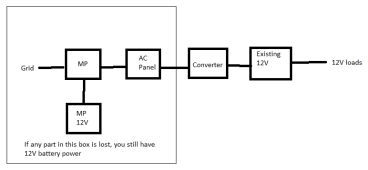I regard the Li version in the manual as a poor implementation without additional information. The way this is worded is that it holds 14.6V and tapers current to ?. Then what? holding LFP at 14.6V is NOT a good idea
I find pretty much all their docs to be lacking and their diagrams look like the were drawn using something like Microsoft Draw back from back in Windows 95. But the do have US support which is nice.
The tech got back to me and there is actually a “copper jumper” that comes with the converter as an option to be installed that enables the converter to contine supplying power to the 12v panel without a battery being connected. Guess Jayco doesn’t bother to use it and doesn’t include it with all the manuals, warranty cards and a couple of parts for things that were installed, at least it wasn’t in the packet we got with trailer but we are the second owners.
He also said that the charge “feature” couldn’t be disabled and his explanation pretty much matched yours in that it isn’t charging the battery specifically, it is increasing the voltage it produces, both charging the batteries and powering the 12v panel simultaneously.
I asked for the jumper wire specs so that I can make one since it seems to just be a short wire, maybe 2 inches long tops. All I want to know is the proper gauge and he responded with a part number, said it could only be purchased through them and that he couldn’t get me a price or availability until Monday. Don’t want to buy one just need to know what gauge it is the only thing I can assume at the moment is that “copper jumper” implies solid wire, not stranded. ?
I’m going to post over on the Jayco Owners forum to see if anyone over there knows because google isn’t helping.
I'm not following you on this one.
I struggled with how to word this so not surprised, might have been clearer if I used volts but I’m realizing that as long as absorption is set to at least be greater than the Charge Wizard’s “normal” charge output mode of 13.6v then it shouldn’t ever matter.
Based on my research so far, I think I’m going to set the MultiPlus to hang out around an effective 3.0v to 3.5v per cell and the BMS with a high disconnect of 3.55v and low of 2.9v. Assuming that the MultiPlus and converter are generally playing well with each other, that should hopefully keep the converter from kicking into boost mode so it won’t be kicking out a charge level of voltage during the MultiPlus absorption phase although the question remains, will the MultiPlus ever go into absorption if there are other active draws on the 12v system? Really wish Progressive Dynamics would specify what level of charge triggers boost mode.
At least initially, I will just turn off the converter’s breaker in the panel unless it’s actually needed that way when power fails or we are traveling or boondocking the converter isn’t drawing battery power to charge the battery since as far as it knows, it would always seem to be on shore power.
I also like it because it's less modification to the original system, and it offers a little more flexibility. let's say the MP is down hard, and your only option is a generator. With the converter and original 12V in place, you don't have to make any provisions to get the 12V system back up
Current path is to leave the existing system pretty much in place as-is, including the converter. Now that I’ve started pulling wire I’ve discovered that the converter is hard wired in, not plugged in. I’m going to leave the original battery circuit breaker and battery disconnect in place for the 12v systems. I’m addng a 400 volt slow blow fuse for the battery connection to the MutiPlus as well as a dedicated battery disconnect.
Otherwise it’s just romex between shore power, MultiPlus and Panel.
Unfortunately even though Victron made a great solution for 50amp RV’s they didn’t really size the MultiPlus II 3000/2x120 large enough for a 50 amp RV. I’m going to have to add a sub-panel to pull our washer and dryer off the main panel and power them using AC Out 2. I’ll probably also move the refrigerator and possibly the bathroom to a sub panel also and take advantage of the existing Xantrex inverter to power them that will give me an effective 4200w vs the 2400w that the MultiPlus has on it’s own. They really should have sized this thing in the 4,000 to 5,000 watt range.



